engine MITSUBISHI ECLIPSE 1990 Workshop Manual
[x] Cancel search | Manufacturer: MITSUBISHI, Model Year: 1990, Model line: ECLIPSE, Model: MITSUBISHI ECLIPSE 1990Pages: 391, PDF Size: 15.27 MB
Page 105 of 391

9-20ENGINE- Lubricathn System
LUBRICATION SYSTEM
nasllOil cooler*
r-4--I-
(oil pressure regulator)
I
n I-1Oil filter
pressureswttch
NOTE
l
: Turbo6LUOO43The lubrication system is the pressure-feed, full-
flow filter system. The engine oil sent under
pressure by the gear-type oil pump is filteredthrough the cartridge-type oil filter before being
delivered to the various engine parts.
SPECIFICATIONS
ItemsOil pump
Type
Delivery rate
Relief valve opening pressure
Oil pressure switch
Type
ON pressureOil filter
Specifications
Gear type
10 cm” (.Sl cu.in.)/engine revolution
550 kPa (78 psi) or more
Contact-point type
30 kPa (4.3 psi) or less
Cartridge type
Page 106 of 391
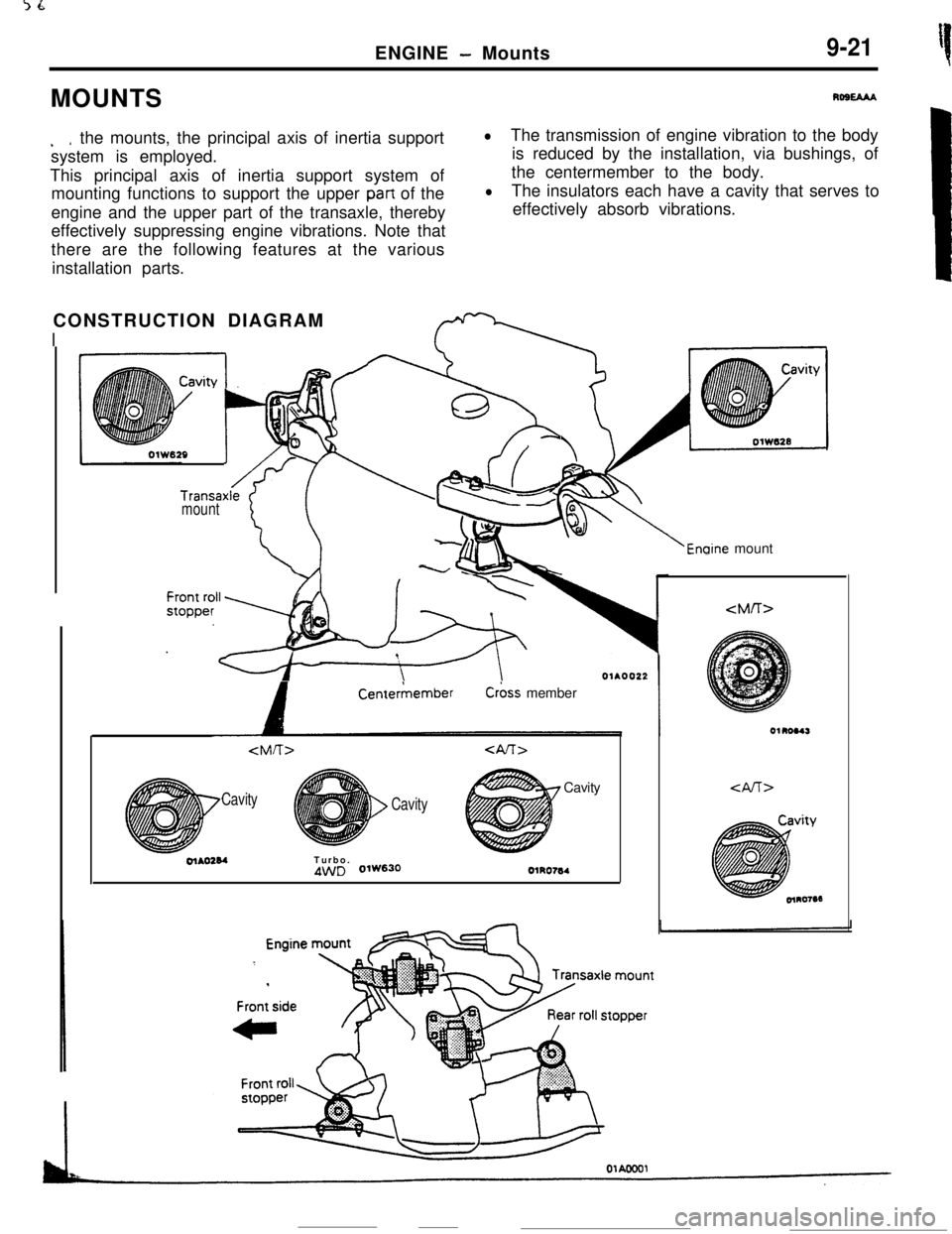
L1ENGINE
- Mounts9-21MOUNTS
Rost3u
. *the mounts, the principal axis of inertia support
system is employed.
This principal axis of inertia support system of
mounting functions to support the upper
part of the
engine and the upper part of the transaxle, thereby
effectively suppressing engine vibrations. Note that
there are the following features at the various
installation parts.
lThe transmission of engine vibration to the body
is reduced by the installation, via bushings, of
the centermember to the body.
lThe insulators each have a cavity that serves to
effectively absorb vibrations.
CONSTRUCTION DIAGRAM
I
Transaxlemount
‘i::
+g
/v 1b-8
8-,
Enaine mount
A
CenterkemberC&s member
Cavity
CavityCavityolAO284Turbo.
4WD 0lW630OlRO764
Page 107 of 391
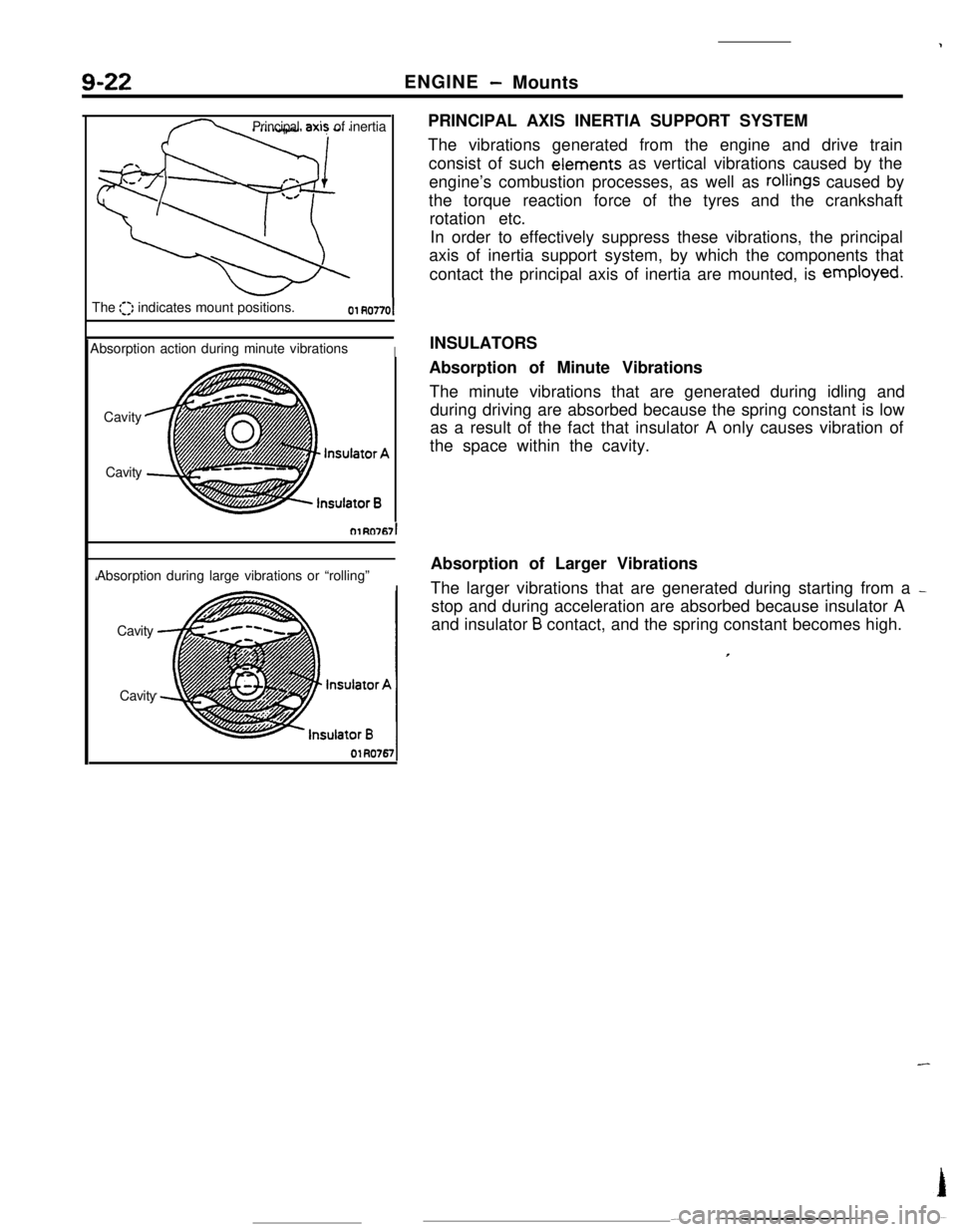
9-22ENGINE- Mounts
Principalaxi? of inertia
The
::I: indicates mount positions.01 RO77OlAbsorption action during minute vibrations
ICavity
CavityOlRcl767l
Absorption during large vibrations or “rolling”
Cavity
CavityPRINCIPAL AXIS INERTIA SUPPORT SYSTEM
The vibrations generated from the engine and drive train
consist of such eiements as vertical vibrations caused by the
engine’s combustion processes, as well as
rollings caused by
the torque reaction force of the tyres and the crankshaft
rotation etc.
In order to effectively suppress these vibrations, the principal
axis of inertia support system, by which the components that
contact the principal axis of inertia are mounted, is employed.
INSULATORS
Absorption of Minute Vibrations
The minute vibrations that are generated during idling and
during driving are absorbed because the spring constant is low
as a result of the fact that insulator A only causes vibration of
the space within the cavity.
Absorption of Larger Vibrations
The larger vibrations that are generated during starting from a
_stop and during acceleration are absorbed because insulator A
and insulator
B contact, and the spring constant becomes high.
Page 114 of 391
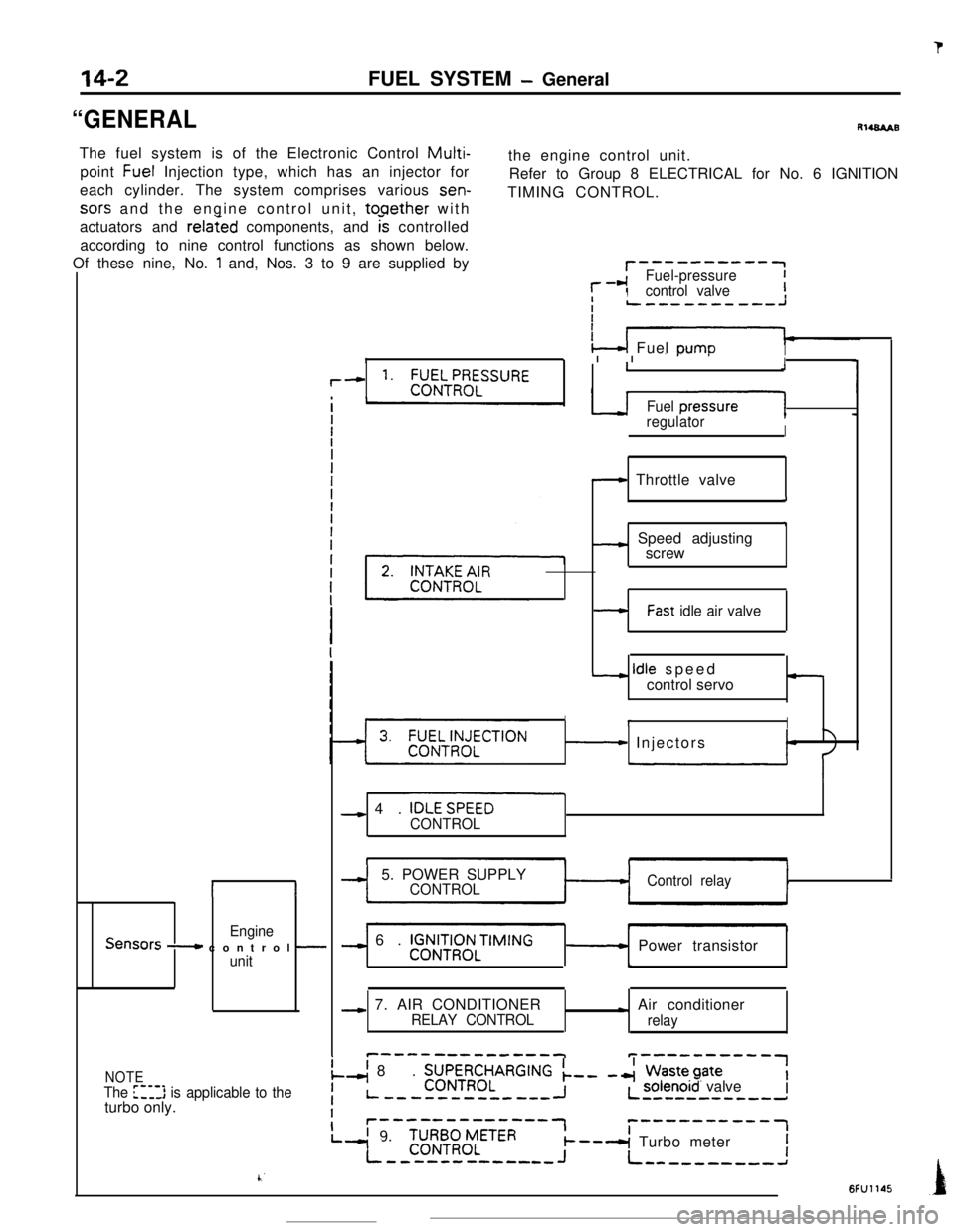
sors and the engine control unit, tooether with
actuators and
related components, and k controlled
according to nine control functions as shown below.
Of these nine, No.
1 and, Nos. 3 to 9 are supplied by
II
EngineSensors - control -unit
r--------‘-1
l--cIFuel-pressureIcontrol valveII
‘4 Fuel DumoI13 I I or-’I
,--c 1. ;;EILT!I;ELSSURE1J
Fuel presJ1regulatorI
- Throttle valve
i
7
_c Speed adjusting
screw
14-2
“GENERALFUEL SYSTEM
- GeneralRl484AB
The fuel system is of the Electronic Control
Multi-point Fuel Injection type, which has an injector forthe engine control unit.
each cylinder. The system comprises various sen-Refer to Group 8 ELECTRICAL for No. 6 IGNITION
TIMING CONTROL.
-Fast idle air valve
- idle speed
control servo-
IrI
- Injectors
- 4. IOLESPEEO
CONTROL
-I5. POWER SUPPLYCONTROLControl relay
-) 6. V$&iRq3NLTIMING- Power transistor
b
-c 7. AIR CONDITIONERRELAY CONTROL- Air conditioner
relay
c-------------Tp----------1
NOTEI
The [‘-,l> is applicable to theI
.-( 8. ZJJ\~RR~LARGING k-- -4 Wastepate
Liturbo only.-----w--------IL solenoid valve--B--------d
Ir-‘---‘---“‘-7c------v--w-1
L’ 9.
-I
‘C;RB;zLETER--A Turbo meterI--------c----J+ L----------a
k’6FU1145
Page 115 of 391
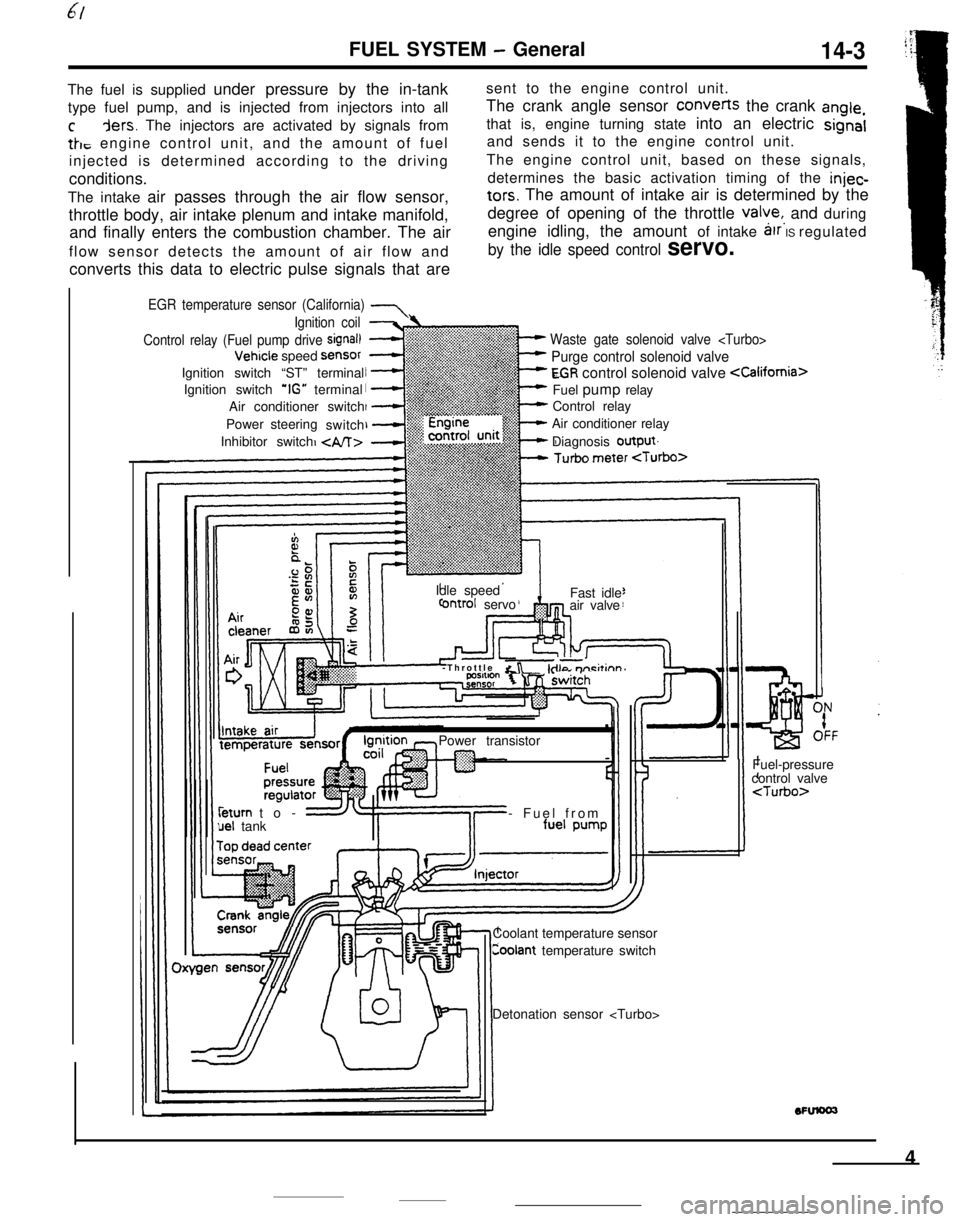
FUEL SYSTEM - General14-3The fuel is supplied under pressure by the in-tanksent to the engine control unit.
type fuel pump, and is injected from injectors into allThe crank angle sensor converts the crank
angle,
cders. The injectors are activated by signals fromthat is, engine turning state into an electric signal
tk, engine control unit, and the amount of fueland sends it to the engine control unit.
injected is determined according to the drivingThe engine control unit, based on these signals,
conditions.determines the basic activation timing of the
injec-The intake air passes through the air flow sensor,
tars. The amount of intake air is determined by the
throttle body, air intake plenum and intake manifold,degree of opening of the throttle
valye,, and during
and finally enters the combustion chamber. The airengine idling, the amount of intake
arr IS regulated
flow sensor detects the amount of air flow and
by the idle speed control servo.converts this data to electric pulse signals that are
EGR temperature sensor (California) 7
Waste gate solenoid valve
Purge control solenoid valve
EGR control solenoid valve
Control relay
Air conditioner relay
Diagnosis output
Ignition coil
Control relay (Fuel pump drive
signal)Vehicle speed
SensorIgnition switch “ST” terminal
Ignition switch
‘IG” terminal
Air conditioner switch
Power steering
switch
Inhibitor switch
Idle speed
ontrol servoFast idle
air valve
-Throttle
&r -kilo m-i&inn’Power transistorleturn to-
uel tank- Fuel from
Coolant temperature sensor
Coolant temperature switchFuel-pressure
control valve
4
Page 116 of 391
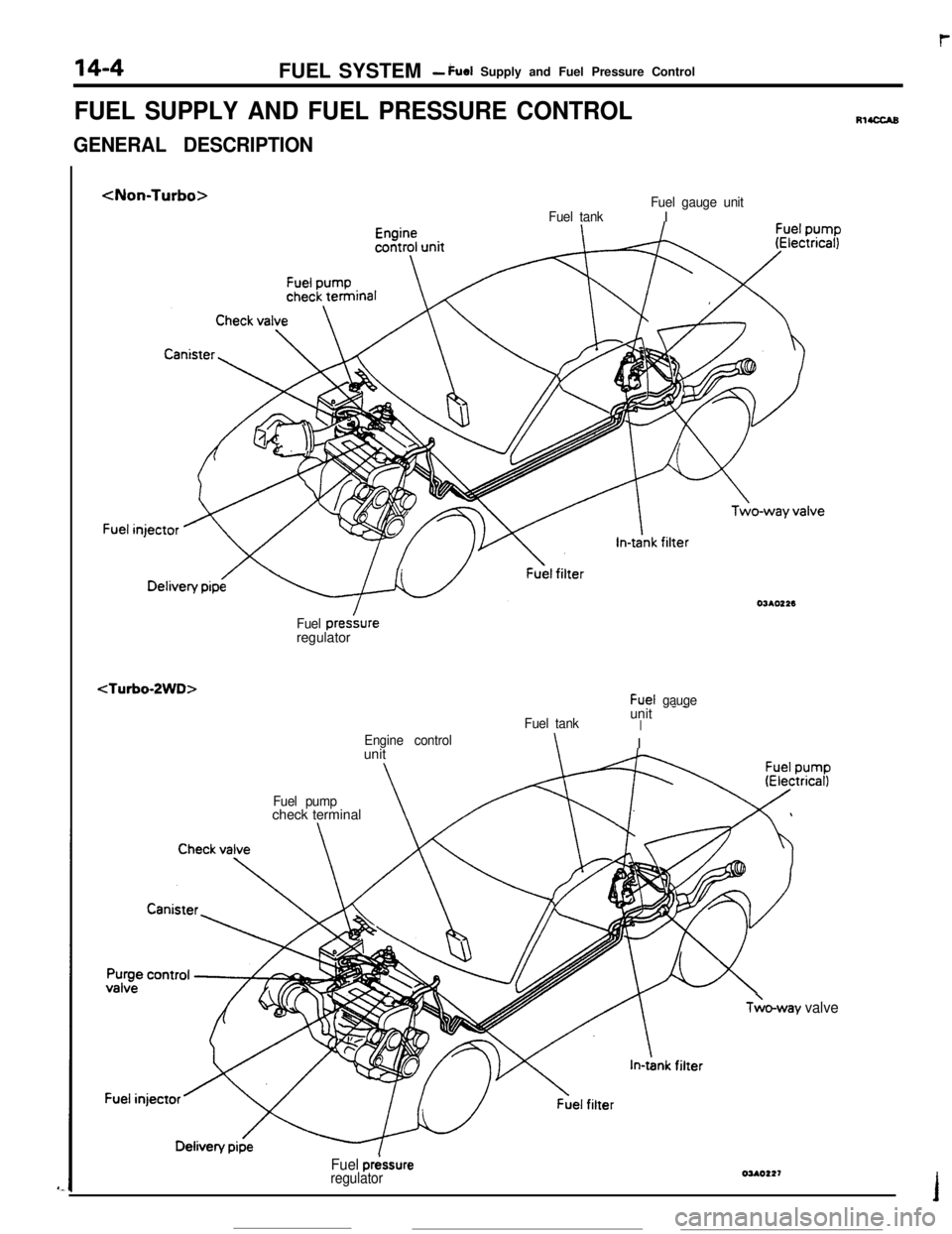
FUEL SYSTEM- duel Supply and Fuel Pressure Control
FUEL SUPPLY AND FUEL PRESSURE CONTROL
GENERAL DESCRIPTION
Fuel tankFuel gauge unitIOJAOt26
Fuel presbreregulator
Fuel tankunit - -IEngine control\I
unit
Fuel pumpcheck terminal\
TLo-way valve
Fuel p&sure
regulatorOUO227
RIUXAB
Page 118 of 391
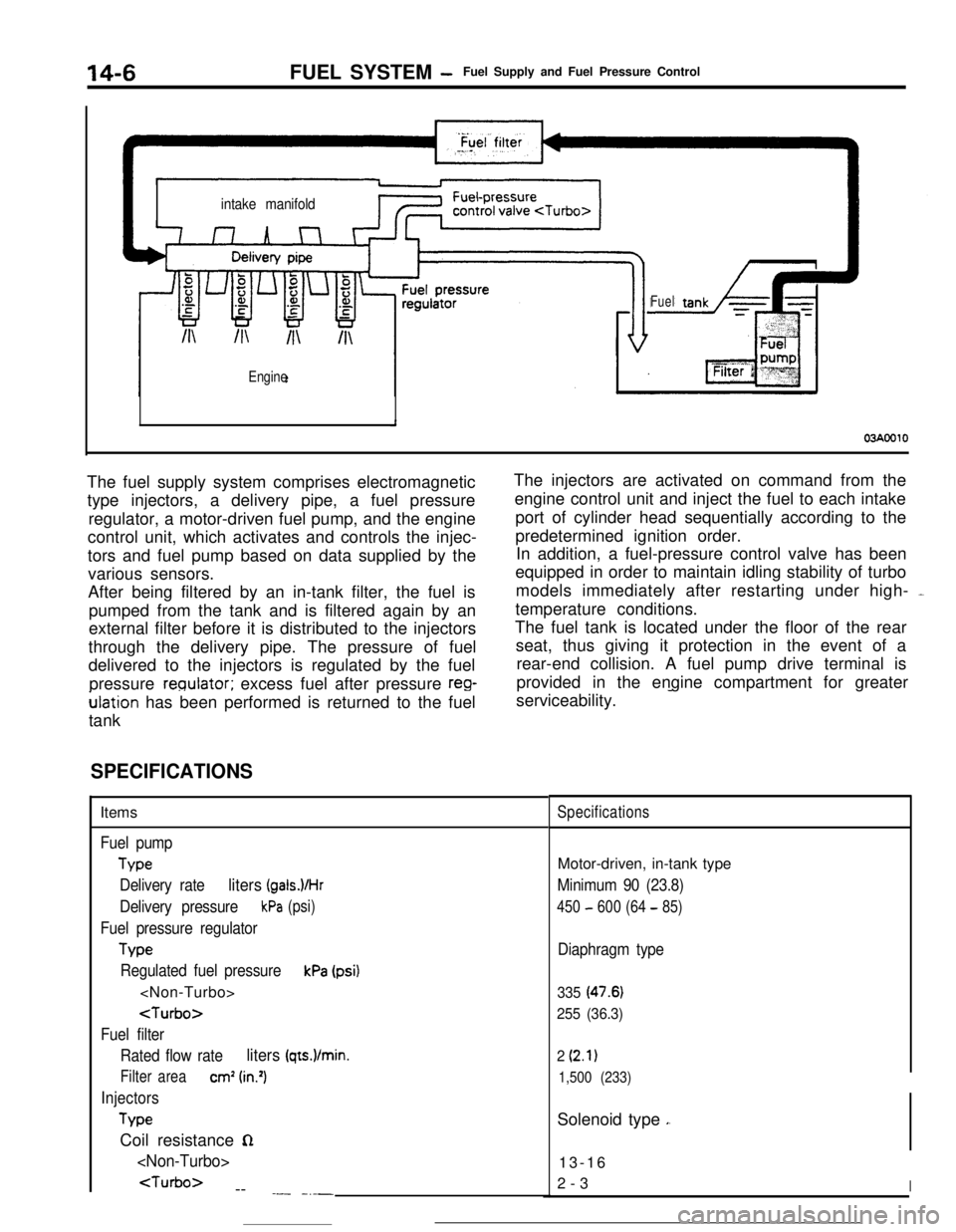
14-6FUEL SYSTEM -Fuel Supply and Fuel Pressure Control
intake manifold/I\
Engine
Fuel
03AOOlOThe fuel supply system comprises electromagnetic
type injectors, a delivery pipe, a fuel pressure
regulator, a motor-driven fuel pump, and the engine
control unit, which activates and controls the injec-
tors and fuel pump based on data supplied by the
various sensors.
After being filtered by an in-tank filter, the fuel is
pumped from the tank and is filtered again by an
external filter before it is distributed to the injectors
through the delivery pipe. The pressure of fuel
delivered to the injectors is regulated by the fuel
pressure
reoulator; excess fuel after pressure reg-ulation has been performed is returned to the fuel
tankThe injectors are activated on command from the
engine control unit and inject the fuel to each intake
port of cylinder head sequentially according to the
predetermined ignition order.
In addition, a fuel-pressure control valve has been
equipped in order to maintain idling stability of turbo
models immediately after restarting under high- -
temperature conditions.
The fuel tank is located under the floor of the rear
seat, thus giving it protection in the event of a
rear-end collision. A fuel pump drive terminal is
provided in the engine compartment for greater
serviceability.
-
SPECIFICATIONSItems
Fuel pump
Type
Delivery rate
liters (gals.VHr
Delivery pressurekPa (psi)
Fuel pressure regulator
Tvw
Regulated fuel pressurekPa (psi)
Fuel filter
Rated flow rate
liters (qts.)/min.
Filter areacm’ (in.‘)
Injectors
TypeCoil resistance
n
--
.- -_-_
SpecificationsMotor-driven, in-tank type
Minimum 90 (23.8)
450 - 600 (64 - 85)
Diaphragm type
335 (47.6)
255 (36.3)
2
(2.1)
1,500 (233)Solenoid type
,.13-16
2-3
I
Page 119 of 391
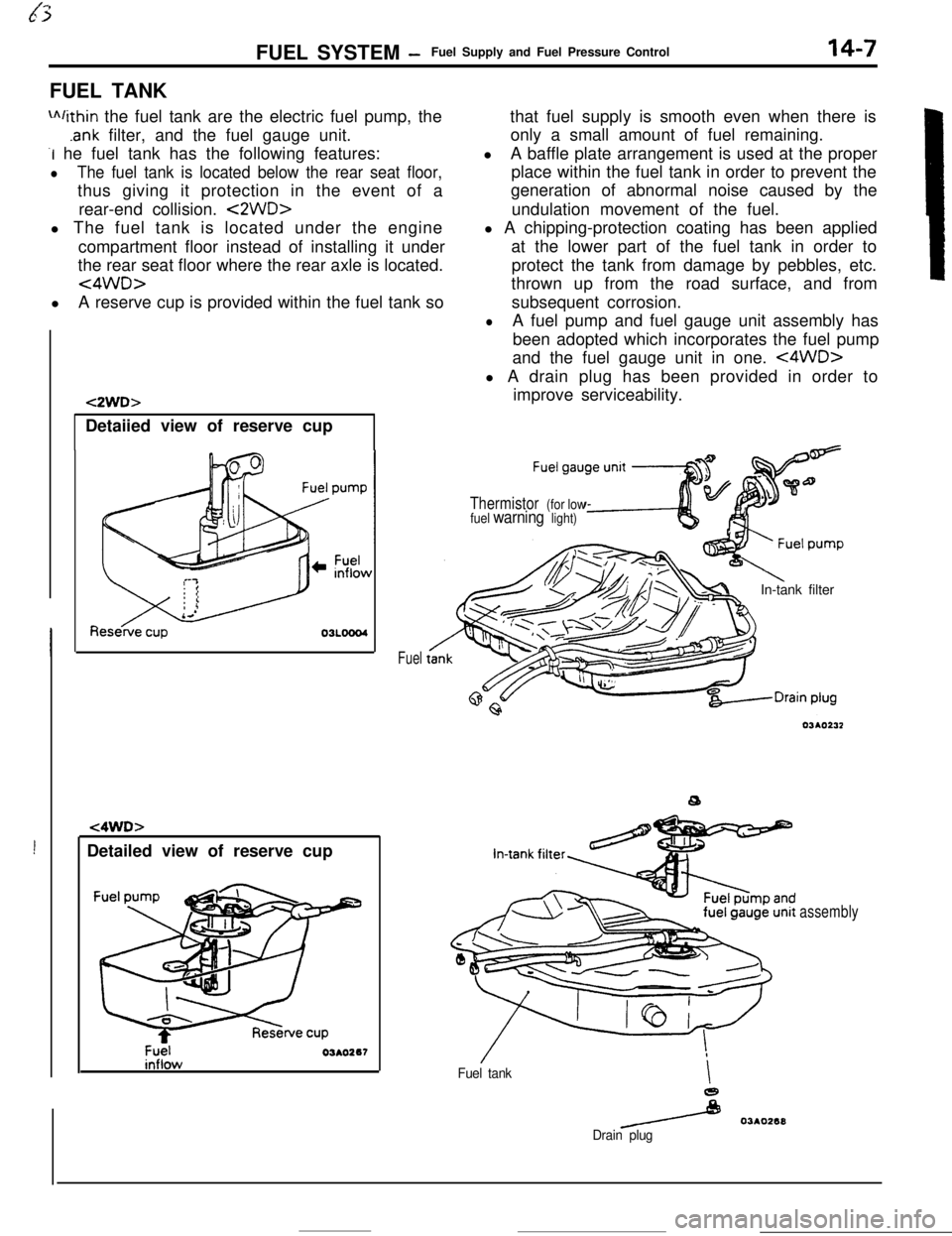
FUEL SYSTEM -Fuel Supply and Fuel Pressure Control14-7FUEL TANK
m/ithin the fuel tank are the electric fuel pump, the
.ank filter, and the fuel gauge unit.
-I he fuel tank has the following features:
lThe fuel tank is located below the rear seat floor,thus giving it protection in the event of a
rear-end collision.
<2WD>l The fuel tank is located under the engine
compartment floor instead of installing it under
the rear seat floor where the rear axle is located.
<4WD>lA reserve cup is provided within the fuel tank so
!Detailed view of reserve cup
t2WD>Detaiied view of reserve cup
t4WD>
Fuel03AO267
Fuelthat fuel supply is smooth even when there is
only a small amount of fuel remaining.
lA baffle plate arrangement is used at the proper
place within the fuel tank in order to prevent the
generation of abnormal noise caused by the
undulation movement of the fuel.
l A chipping-protection coating has been applied
at the lower part of the fuel tank in order to
protect the tank from damage by pebbles, etc.
thrown up from the road surface, and from
subsequent corrosion.
lA fuel pump and fuel gauge unit assembly has
been adopted which incorporates the fuel pump
and the fuel gauge unit in one.
<4WD>l A drain plug has been provided in order to
improve serviceability.
Thermistor (for low
fuel warning light)In-tank filter
Fuel tankI
e
/ 03AO268
Drain plug
assembly
Page 120 of 391
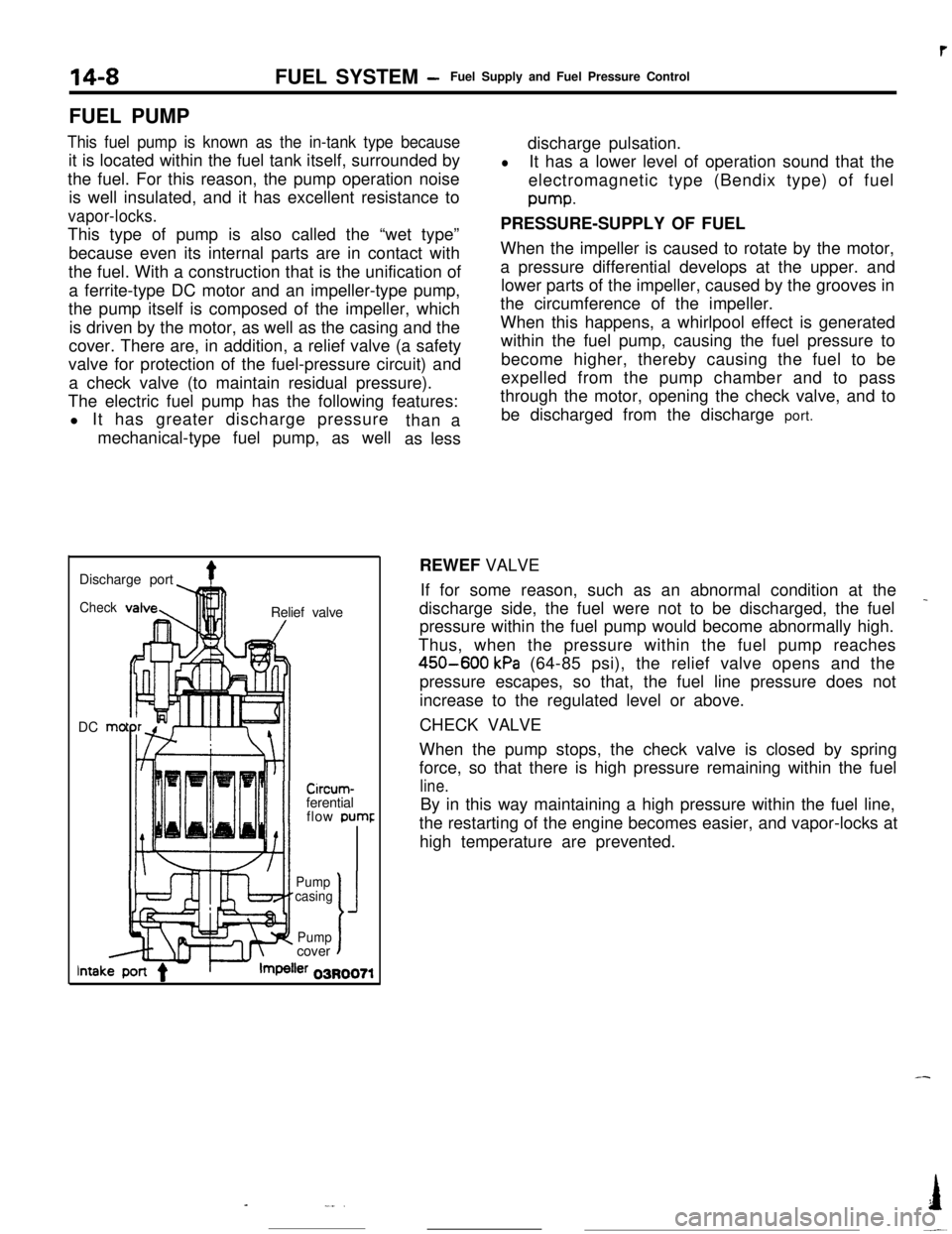
14-8
rFUEL SYSTEM
-Fuel Supply and Fuel Pressure Control
FUEL PUMP
This fuel pump is known as the in-tank type becauseit is located within the fuel tank itself, surrounded by
the fuel. For this reason, the pump operation noise
is well insulated, and it has excellent resistance to
vapor-locks.This type of pump is also called the “wet type”
because even its internal parts are in contact with
the fuel. With a construction that is the unification of
a ferrite-type DC motor and an impeller-type pump,
the pump itself is composed of the impeller, which
is driven by the motor, as well as the casing and the
cover. There are, in addition, a relief valve (a safety
valve for protection of the fuel-pressure circuit) and
a check valve (to maintain residual pressure).
The electric fuel pump has the following features:
l It has greater discharge pressure
mechanical-type fuel pump, as wellthan a
as lessdischarge pulsation.
lIt has a lower level of operation sound that the
electromagnetic type (Bendix type) of fuelpump.
PRESSURE-SUPPLY OF FUEL
When the impeller is caused to rotate by the motor,
a pressure differential develops at the upper. and
lower parts of the impeller, caused by the grooves in
the circumference of the impeller.
When this happens, a whirlpool effect is generated
within the fuel pump, causing the fuel pressure to
become higher, thereby causing the fuel to be
expelled from the pump chamber and to pass
through the motor, opening the check valve, and to
be discharged from the discharge port.
Discharge port
4Check!nRelief valve
DC mo
-lllll1 I/
Circum-ferential
flow pumr
II’ f-Pump
casing
J
Pumpcovert
lntakler 03R0071REWEF VALVE
If for some reason, such as an abnormal condition at the
_discharge side, the fuel were not to be discharged, the fuel
pressure within the fuel pump would become abnormally high.
Thus, when the pressure within the fuel pump reaches
450-600 kPa (64-85 psi), the relief valve opens and the
pressure escapes, so that, the fuel line pressure does not
increase to the regulated level or above.
CHECK VALVE
When the pump stops, the check valve is closed by spring
force, so that there is high pressure remaining within the fuel
line.By in this way maintaining a high pressure within the fuel line,
the restarting of the engine becomes easier, and vapor-locks at
high temperature are prevented.
-
-_..I
-~
Page 122 of 391
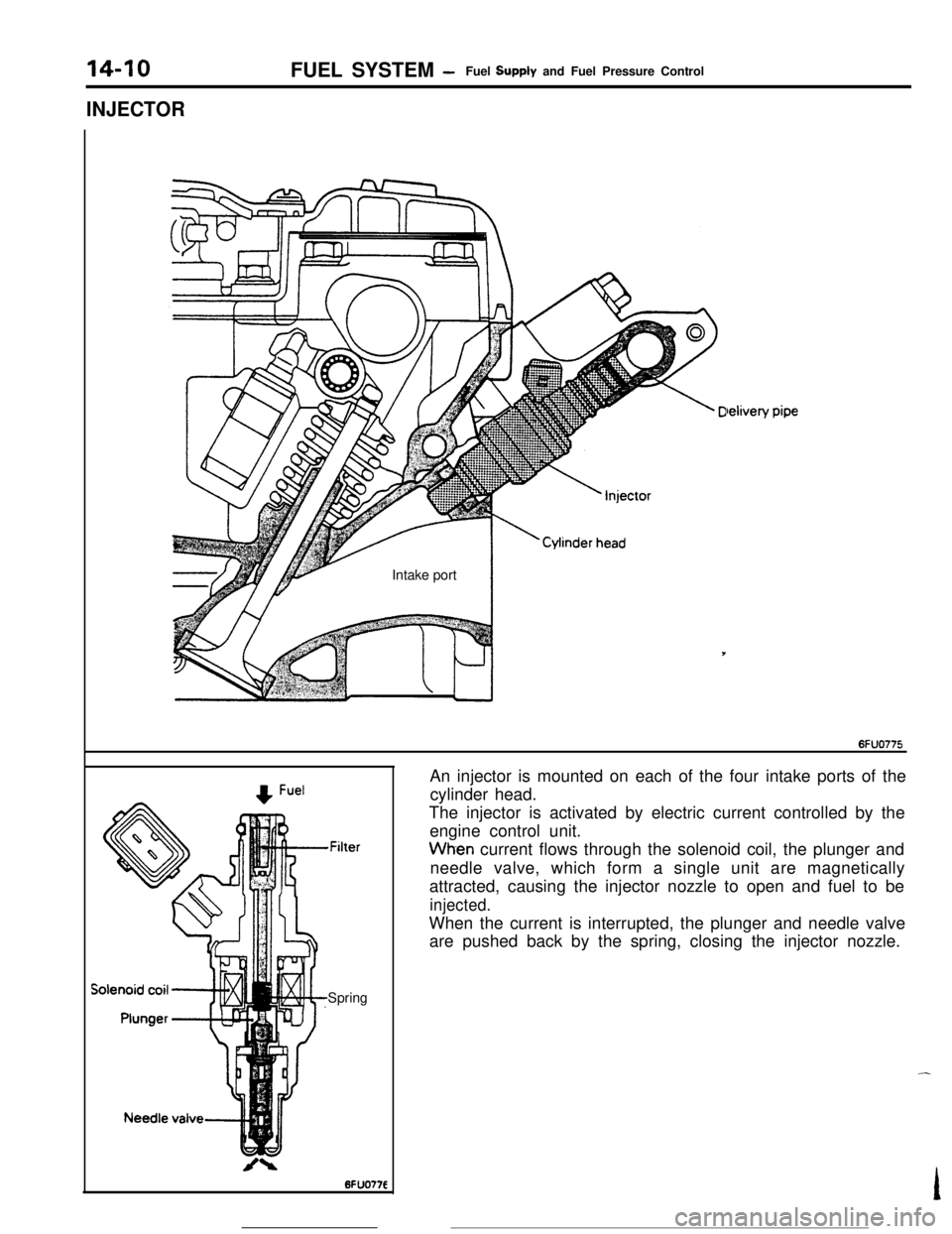
14-10
INJECTORFUEL SYSTEM
-Fuel Supply and Fuel Pressure Control
Intake port
lelivelYPipte
,FilterSpringAn injector is mounted on each of the four intake ports of the
cylinder head.
The injector is activated by electric current controlled by the
engine control unit.Wh-en current flows through the solenoid coil, the plunger and
needle valve, which form a single unit are magnetically
attracted, causing the injector nozzle to open and fuel to be
injected.When the current is interrupted, the plunger and needle valve
are pushed back by the spring, closing the injector nozzle.